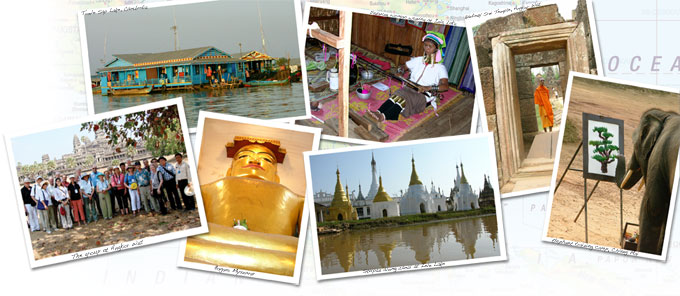 Summer 2007
Summer 2007 A Traveler’s Diary: The Jeweled Kingdoms of Southeast Asia
February 2007 will leave an indelible impression on many Pittsburghers because of its fierce ice and snow, but others will recall the warm tropical nights of a distant land and all the wonders that Southeast Asia offers to dazzle the traveler. It was in February that my husband, Chris Beard, head of Vertebrate Paleontology, and I had the opportunity to head a Carnegie Museum of Natural History trip filled with amazing sights and adventures. Extreme SightsSoutheast Asia is a land of extremes. Some are geographic, from the beautiful beaches of the Andaman Sea, to the flat dry rice fields, to the highland rainforest skirting the Tibetan Plateau. Others are climatic, with three seasons being dry, hot, and wet, as in monsoon season. We chose the dry season for our adventure, which just happened to lift us right out of our extreme blizzard season at home!
As a natural history tour, our travel was designed to illustrate the paleontology, archaeology, biodiversity, environment, and indigenous peoples of Southeast Asia to the best extent possible in a brief two weeks. In Bangkok, we met a leading Thai paleontologist, Yaowalak Chaimanee, who collaborates with Chris and other colleagues at fossil sites in Myanmar. She delighted us with some unique and priceless skulls and jaws of animals that wandered through this land some 10 to 35 million years ago. Siamopithecus, an early monkey from the end of the Eocene period, is one of the oldest fossil mammals ever found in Thailand. She also let us examine the remains of other animals with difficult-to-pronounce names, such as Siamotherium, an ancestor of modern hippos, and Khoratpithecus, a close relative of living orangutans. Later, in Myanmar, Chris lectured to our group about his own Eocene primate localities that lay just across the Irrawaddy River and over a few hills toward the setting sun. He also gave us a tour through the National Museum of Myanmar in Yangon (Rangoon) and pointed out fossils of primates and other animals recovered during his team’s expeditions. Southeast Asia, it turns out, was not a cul-de-sac off the beaten path millions of years ago. Rather, it was the birthplace of many lineages of animals that are still important today and that ventured out to Africa, India, and even North America. The Southeast Asia we see today differs immensely from the environment that Siamopithecus called home during the Eocene period, and humans have had much to do with the changes. We saw a few kingfishers on Inle Lake in Myanmar, and some remnant forests in the hills of northern Thailand. But beyond that, most of the plant and animal life has been domesticated or relocated by humans. As a zooarchaeologist, however, I was delighted to make the acquaintance of a friendly albino water buffalo that patiently invited couples from our group to pose on his back. After decades of studying the origins of animal domestication, I stood in awe of the intelligence and skill of the Indian elephants we encountered at an “elephant training camp” in northern Thailand. I was beginning to wonder why they never developed their own civilization, especially after the one closest to our group produced a stunning painting of a Bonsai tree. Without anthropomorphizing too much, it did seem that those elephants were really having a great time playing soccer, and bowing to the audience, and I swear they were smiling as they frolicked in the river. Beauty ReignsThe real heart of Southeast Asia is its people. Those of the distant past are remembered by their grand architecture and monumental temples, which are unmatched anywhere else on Earth. The living descendants of these ancient civilizations are no less remarkable, whether they toil at rice farming in a monsoonal climate, manufacture intricate handicrafts of wood, lacquer, and plant fibers, or gain religious merit through prayer and meditation.
To be sure, religion lies at the core of Southeast Asian society, permeating many daily activities. Buddhism dominates today, but the prominence of Brahman Hinduism is nowhere more evident than in the complex of temples at Angkor Wat. With all of that state religion dominating for hundreds of years, it is a bit curious that every house in Myanmar has a spirit house to feed and appease the nats, the cantankerous spirits surviving from ancient animistic traditions. Although in ancient times the rulers of Burma, Siam, and Cambodia alternated in seizing power—as well as gold and slaves—from their neighbors, today the stranger is always greeted with politeness, sincerity, and thoughtfulness. Hundreds of different languages are still spoken by small ethnic groups, especially those around Inle Lake and up in the northern hills. They express their cultural pride through the colors and styles of their clothing, in their music, and in their fine crafts. The most striking thing about Southeast Asia, in fact, is the attention to beauty. Despite the economic constraints on these lovely people, they weave intricate and vibrant silks, bring life to their woodcarvings, create dishes that delight the eye as well as the palate, and even take time to delicately fold the petals of lotus blossoms, as though they were origami. As our trip drew to a close, we knew that we were taking home our souvenirs, photographs, and all the shared memories that will keep our bond with each other strong, and will beckon us to return to this beautiful land one day. |
Pittsburgh Glass · Time to Play · A New, More Personal Jesus · Mars Comes to Pittsburgh · Special Supplement: Thanks to Our Donors · Director's Note · NewsWorthy · Now Showing · Face Time: Anthony Rothbauer · About Town: Art Imitating Life · Field Trip: On the Road with Douglas Fogle · Science & Nature: Working the Bones · Artistic License: The Traveling Factory · Another Look: Sol LeWitt Drawings
 |
Copyright © 2017 CARNEGIE Magazine. All rights reserved. |
